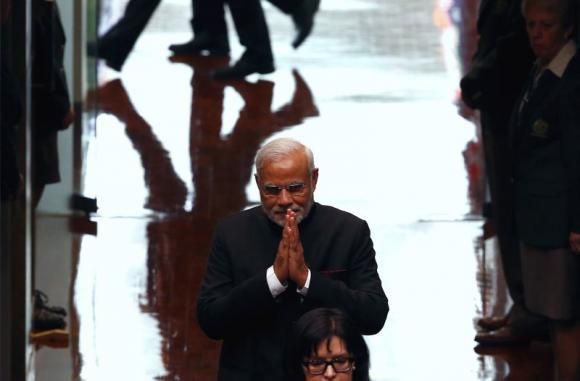The Make in India campaign harks back to the historical idea of Swadeshi.

A little knowledge of India's history may help make a sense of the new policy.
Swadeshi - the manufacture and trade of local goods in preference to imports - was thought up by ideologues of the Independence movement.
It was a counter to colonial policy.
The British bought raw commodities like cotton, jute, and base metals, from India, while discouraging Indian manufacturing.
British factories turned commodities into value-added items like clothes, cutlery, etc, and sold those back to India.
When the Swadeshi movement started, Indian goods were shoddy and more expensive than the imports they competed against.
But Swadeshi satisfied national pride and reduced the exploitation of India as a captive colonial market.
It also brought the local business community on board with the concept of Independence - entrepreneurs sensed opportunity.
After Independence, Swadeshi became "import-substitution".
Local industry was given protection from imports and manufacturers with political influence got protection against local competition as well. So, private sector monopolies developed.
The government also set up its inefficient, monopolistic public sector units.
To add to the issues, complex labour laws and aggressive unionisation led to industrial unrest.
The protectionist policies and licensing made Indian goods, by and large, uncompetitive in global markets.
The policy of import substitution might still have worked if it had not failed to account for one obvious detail.
India would always be a massive net crude oil importer and crude imports could not be substituted.
The trade balance is always going to be adverse for India if it lacks the exports to counter-balance crude oil imports.
Whenever crude oil prices are high, India's economy is under pressure.
In 1991, the Iraqi invasion of Kuwait led to a sudden spike in oil prices and pushed India close to bankruptcy.
That's when these protectionist policies were slowly, partially reversed. Now take a look at the Make in India policy, which aims to turn India into a "global manufacturing hub".
Ignoring rhetoric, the demographics of India are all about a young, under-skilled workforce.
There is a compulsion to create employment for the 1 million people who join the workforce every month.
Manufacturing is one route to mass employment but the history of protection, complex labour laws, etc, makes it harder to get manufacturing off the ground.
A long list of sectors are covered under Make in India.
There is a laudable attempt to reduce red tape, enhance foreign direct investment limits, prune labour laws and environmental clearance processes, and in general to speed bureaucratic processes up.
Some sectors like information technology, automobile-components, pharmaceuticals, etc, are globally quite competitive.
Some sectors, such as defence manufacturing, food processing, electronics are not competitive.
Some are reasonably competitive like electrical machinery, textiles and leather. Some listed sectors are infrastructure-related like ports, roads, aviation, thermal power, renewable energy, mining, oil and gas, railways, etc.
In addition, there is construction, which is arguably a services sector, heavily driven by infrastructure contracts.
There is also tourism & hospitality, which is definitely services but probably included due to the potential for employment.
Unfortunately, there is a lot of dead-wood, in the form of bad loans and stalled projects. Many construction firms are suffering from the overhang of stalled infra projects.
If Make in India can improve that situation, it could help unlock up to 15 per cent of India's gross domestic product sunk in unviable infra projects.
Obviously, building better infrastructure will also lead to more competitive manufacturing.
Make in India will surely create investment opportunities but these will be unevenly distributed.
It is unlikely India can play catch-up and compete in certain areas.
But a better policy environment could emphasise existing competitive edge and also energise potentially more competitive sectors.
There is also the law of comparative advantage.
Say, a country has competitive advantages over a rival nation in the production of two goods.
It could still make sense to focus on producing only one good, where the comparative advantage is larger.
There are areas where Indian manufacturing doesn't have any competitive advantage.
There are areas of small competitive advantages.
It might be best to ignore those areas and focus purely on those sectors with large advantages.
If Make in India is poorly implemented, or badly thought it will cause misallocation.
But if it is well thought-out, it will create more infrastructural capacity and improve the policy environment. Either way, it is long-gestation.











 © 2025
© 2025